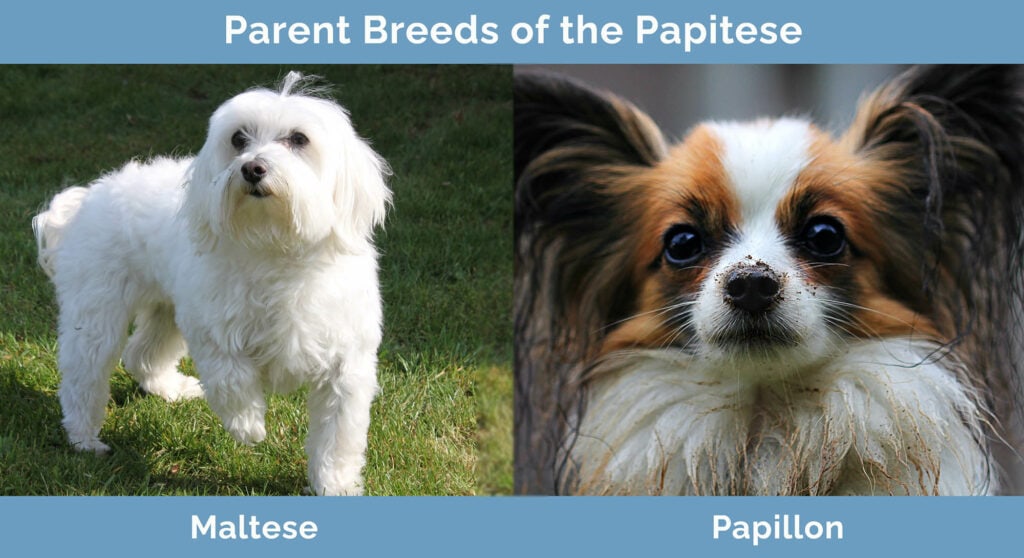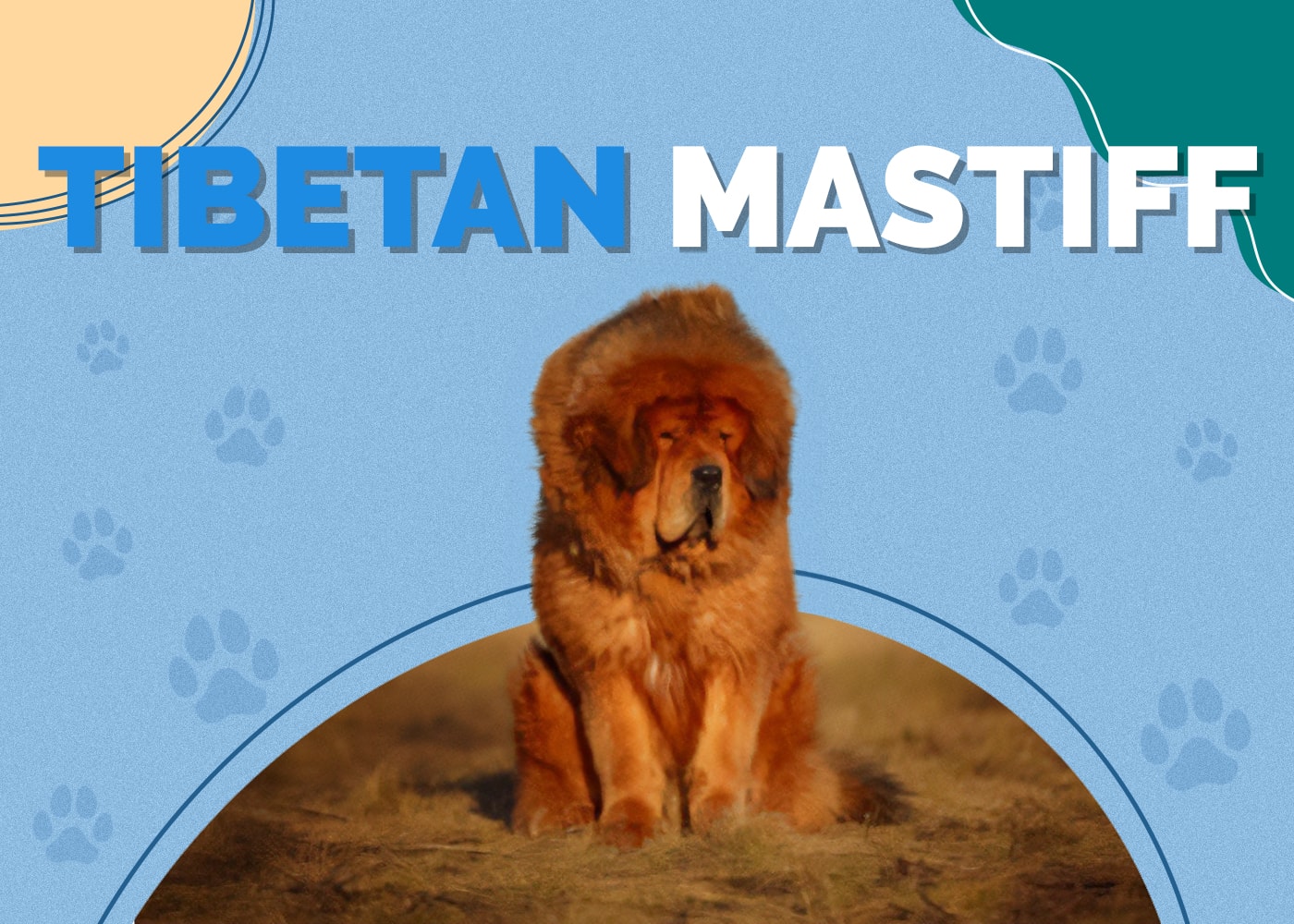Papitese (Maltese & Papillon Mix): Info, Pictures, Characteristics & Facts

Updated on

| Height: | 8-10 inches |
| Weight: | 8-12 pounds |
| Lifespan: | 14-15 years |
| Colors: | White, gold, cream, brown, black, silver, blue |
| Suitable for: | Small apartments, family homes, children, elderly, indoor companionship |
| Temperament: | Friendly and affectionate, but develops separation anxiety easily and requires constant interaction |
The Papitese is a mixed breed toy dog that blends the Maltese and the Papillon. Some people refer to this dog as a Maltillon. It has a happy face and medium length silky hair that is slightly wavy. It has a broad muzzle and sometimes has the butterfly style ears of the Papillon.
The Papitese origins are unsure and not well documented, but are believed to be an American design. Because of their lack of history, most people look to the parents for behavior traits.
Papitese Puppies

When you’re looking for a Papitese, make sure you take your time to find a reputable breeder. High-end breeders will cost more but often result in a puppy that is healthier and has a longer life expectancy due to the care that goes into breeding them. Lower-grade breeders often don’t have the knowledge to spot and eliminate health risks. Puppies bred in puppy mills live in hazardous conditions with little care for the welfare of the dogs, or the puppies.
You can also look into adopting a Papitese; try visiting a couple of dog shelters and you may fall in love with a pup that needs lots of love. You can also end up saving lots of money by adopting.

Temperament & Intelligence of the Papitese 🧠
The Papitese is an extremely social dog that loves to be near family members. It requires constant companionship or can quickly develop separation anxiety. It’s very friendly toward children as well as the elderly, and they make the perfect indoor companion. Their small size makes them vulnerable to injury, especially from wrestling with small children, and it prevents them from being effective watchdogs. However, they are very nosey and will quickly alert you to anything happening around the house.
The Papitese is a smart dog that loves to please you and will happily spend time learning new tricks.
Are These Dogs Good for Families? 🏡
Yes, The Papitese is a great dog breed to have in the home. The Maltese in them can make it slightly hard to housetrain them, but with a little patience, even the most stubborn pets will learn to go outside to relieve themselves. They are extremely friendly and playful, so the children will love them, and you won’t need to worry about the dog knocking over the toddlers. Because of their size, the children can hurt them, so it’s important to discourage rough play.
The Papitese also make great companions for the elderly because they don’t require a lot of outside time and are fairly low maintenance.
Does This Breed Get Along with Other Pets? 🐶 😽
Yes. The Papitese is extremely friendly towards other household pets and rarely the instigator in any disputes that do occur. Their curious nature may cause them to follow your other pets around, but they are usually more than content to watch and not get into trouble.
Things to Know When Owning a Papitese
The Papitese is easy to take care of and requires minimum daily grooming, but let’s take a closer look at what you can expect.
Food and Diet Requirements 🦴
The Papitese is a small dog that rarely exceeds 10 pounds, so you will not be required to feed it too much. These dogs usually need about 1 cup of food per day, spread out over three meals. There are many brands of dog food available for toy breeds and small breeds, but you shouldn’t need them if you feed them a high-quality brand that provides balanced nutrition without chemicals or preservatives.

Daily Exercise Requirements🐕
The Papitese is a moderately active dog. If it were larger, it might be challenging to provide the exercise needed, but as it is, it only requires about 30 minutes per day to stay healthy and trim. In most cases, you can perform this exercise in the house, but the occasional run in the yard or walk around the block will be beneficial as well.
Training 🦮
Except for housetraining, the Papitese is intelligent and eager to learn new tricks. You can teach your dog dozens of tricks by following the next few steps.
Training Your Papitese
- Choose a short name for your trick like bark, sit, or stay. Start easy.
- Stand in front of your pet, getting their attention by holding a treat.
- Repeat the name of your trick while coaxing them on what to do.
- When they complete the trick, give them the treat.
- Repeat two or three times a day.
After a few days, your Papitese should catch on and perform the trick on the first command to get the trick. Some tricks can be performed without treats once in the habit of performing on command. It’s important not to overdo it, especially if your pet is having difficulty with a certain trick, because it will give the dog the impression that it’s not pleasing you.
Grooming ✂️
The Papitese has dense fur but requires surprisingly little grooming. Daily brushing to remove loose hair and dirt should be adequate for most owners. The occasional nail clipping and hair cut is also recommended along with tooth brushing to promote healthy teeth and gums.
Health and Conditions ❤️
The Papitese is a healthy dog with a long life expectancy, and many owners have many years with only routine vet visits. There are a few problems that can occur, though, so let’s look at them here.
- Patellar Luxation
Patellar Luxation is also known as “trick knee,” and it is a condition where the knee dislocates or moves out of its normal location. There are several degrees of Patellar Luxation, which get worse as the pet ages, and it affects how much weight your dog can place on the leg. Patellar Luxation is a common problem with all toy breeds
- Glaucoma
Glaucoma is a disease that causes increased pressure within the eye. The pressure is caused by fluid not properly draining from behind the eye. Signs of glaucoma include watery eyes, lethargy, and loss of appetite. They may even close one eye partially or attempt to rub it. Glaucoma can lead to blindness very quickly, so if you notice any of these signs, it’s important to get your dog to the vet.
- Portosystemic Shunt
A Portosystemic Shunt is an abnormal connection between the portal and systemic parts of the circulatory system that often affects the Maltese parent of the Papitese. This disease can result in an abnormally small liver, which leads to more toxins in the bloodstream. As this condition progresses, it often affects the central nervous system.
- Patent Ductus Arteriosis
Patent Ductus Arteriosis is a condition that occurs when a shunt between two arteries leading away from the heart before birth does not properly close after birth. This condition causes one side of the heart to work harder than the other, which leads to irregular heart development and can lead to congestive heart failure.
Male vs Female
Male and female Papitese dogs are extremely similar and difficult to tell apart. Fully grown, they are nearly identical in size and appearance. Their personality is more individual-based than sex-based, and the only real difference we noticed was that the females liked to spend a little time alone and tend to have a private place. It would take some time to notice this behavior, though it’s not something you will see right away.
3 Little-Known Facts About the Papitese
1. The Maltese are also known as the Ancient Dogge of Malta.
2. The Maltese are more than 28 centuries old.
3. Papillon is French for butterfly.
Conclusion
We hope that you have enjoyed our in-depth look at the Papitese mixed breed. These are friendly dogs that will make a great addition to any family. They don’t require a lot of grooming, eat very little, and have a long lifespan. They are at home in a small apartment and don’t require a lot of exercise. If we have helped you learn a little more about this amazing toy breed, please share this guide to the Papitese on Facebook and Twitter.
See Also:
- 10 Best Chew Toys for Dogs
- Papijack (Papillon & Jack Russell Terrier Mix): Info, Pictures, Characteristics & Facts
Feature Image Credit: Steve Bruckmann, Shutterstok













